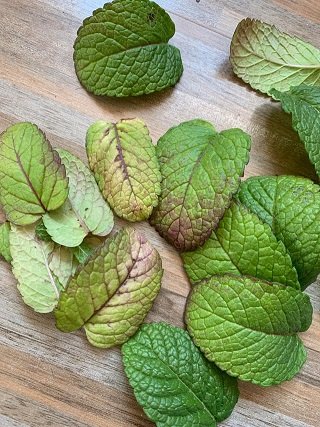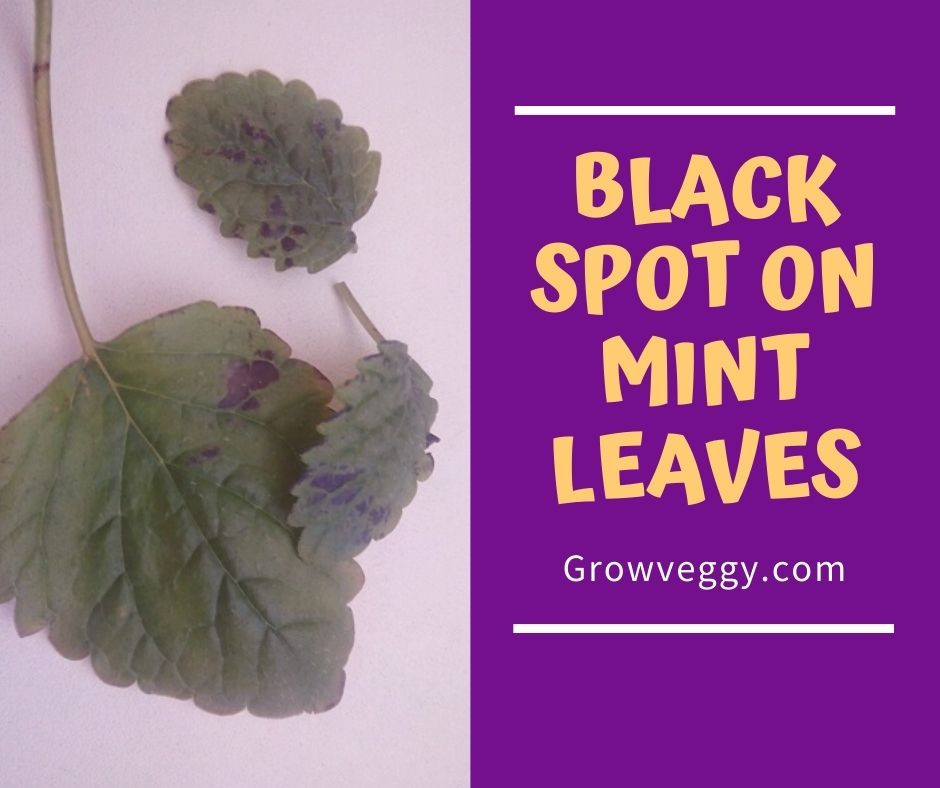The fresh mint plant needs some more care than just being watered. So, when you see black spots on the mint leaves, it could be a reason to worry.
Causes of Black Spots on Mint Leaves include Overwatering, Humidity, and heat, Mint rust, Over-fertilization, Leaf blight, Mint aphid, etc
7 Causes for Black Spots on Mint Leaves and ways to fix
1. Overwatering and poor drainage
Mint plants require regular watering, but overwatering can lead to overgrown roots and black or brown spots near the roots or on the bottom layer of the plant.
Overwatering also creates a lot of moisture, which leads to fungal diseases like root rot or powdery mildew. This also creates black or white spots on the mint leaves.
Mint plants have sensitive root systems, which is why insufficient drainage can cause stress to the roots of the plant.
Mint grows best in light soil with sufficient drainage to allow water to flow easily and keep the roots healthy.
Tip – Check for healthy leaves at the top of the plant. If the top leaves are healthy and black spots are present only on the leaves at the bottom, then it is most likely a drainage issue.
Solution
You can follow the below steps to revive the mint plant
Remove the black leaves:
The first step is to remove the parts of the plant that have black spots or have turned black or brown.
Water your plant less:
Water your plants less, especially during the cooler months when the water does not evaporate easily. Decrease the amount as well as the frequency of the water.
Start watering every three to four days, if the climate is humid enough.
Re-Pot your mint plant:
If you can see roots poking out of the drainage holes of the container that your mint is planted in, you know it is time to transfer your plant to a bigger pot or divide the plant into two.
If you want to divide the plant into two, you can take a cutting from the plant or layer the plant. Both options are safe to use to keep your plant healthy and natural.
If you don’t want to divide your plant, you can just relocate it to a bigger pot. Roots poking out of the holes mean that the plant needs more space to breathe and grow properly.
Create a good drainage system:
Make sure you are using the right kind of soil. Mint requires well-drained, moist, and loamy soil with organic matter.
Make sure the container your mint is planted in has at least 2 to 3 holes at the bottom. The holes will ensure that just enough water stays in the soil, while the rest flows out easily.
In case you do overwater the mint, there is scope for the excess water to drain out.
2. Humidity and heat
Mint grows best in full sun to partial shade. However, direct exposure to high heat can turn your mint black by drying or burning up the leaves.
Even in areas with very high humidity, the water dries up very fast, which makes the mint plant stressed as a result of which, it turns black.
Solution
Relocate your plant:
If excess heat is a problem for your plant, relocate the plant to a cooler place where it can get some shade.
Mint does require sunlight to grow well, so make sure your plant is not kept in a place that does not get any sunlight.
The ideal place would be where the plant can get a few hours of sunlight in the morning but the heat of the noon sun does not dry it up.
Increase watering frequency:
When you move the plant to a cooler spot with sunlight still getting through, there is a possibility of high humidity in the place.
Because of this, the water will still evaporate faster, leaving the roots dry.
Therefore, you might need to water the plant once or twice a day, without increasing the amount of water.
Keep the amount of water the same, while increasing the number of times you water the plant.
3. Mint rust

Mint rust is a very common disease among mint and other plants of the herb family, like basil and oregano. Peppermint and spearmint are especially prone to mint rust.
Mint rust causes black spots on the underside of the leaves. The leaves start to turn yellow or orange.
As the disease grows, entire leaves start turning black. Mint rust develops because of fungal spore infestation.
It is very important to treat mint rust as soon as possible because it starts to weaken the plant.
Not only that, it can lead to other fungal diseases, such as fungal spores looking like black balls developing on the mint leaves.
Solution
Following are some instructions that you can follow to prevent any further damage from mint rust.
Isolate the plant:
First and foremost, isolate the affected mint plant from the rest of the plants so that the disease does not spread to other plants.
Separate infected leaves:
If you think that the disease is still in the early stages, remove the infected leaves or the infected parts of the plant.
Dispose of the affected part by throwing it away or burning it. Make sure that the infected part is nowhere near any of your plants or your soil.
Provide better aeration:
Check if your mint is congested, or if there is humidity among the leaves. If there is, you need to let in some air so that the plant can breathe and dry properly.
You can do so by trimming off excess mint leaves, or leaves that are starting to wither away.
If your mint plant is in a corner spot or somewhere near the wall, change its location to an airier spot so as to increase the airflow around the plant.
Change the watering technique:
The main cause of mint rust is drops of water collected on the mint leaves. That is why you need to change the way you water your plant.
Start watering your mint from below and then move upwards. Also, make sure that you water early in the morning so that the water drops on the leaves have enough time to evaporate.
Apply fungicide:
If the infection has advanced further, you might need to use a fungicide. You can apply fungicide to your mint plant as a last effort to save your plant.
There are a lot of fungicides available in the market that not only undo the effects of the fungus but also allow you to harvest faster.
4. Over-fertilization
Mint requires fertilizer every now and then in order to grow better and stay healthy. However, over-fertilization can cause a lot of problems.
Over-fertilization adds too many nutrients to the soil. This can hamper the growth of the plant and also allow the growth of weeds. It eventually makes the mint at risk of getting diseases.
Over-fertilization damages the roots of the mint and the leaves of the plant start developing black spots. This is also known as fertilizer burn.
It also attracts other bugs and pests, which attack the plant.
How to determine if your plant is over-fertilized?
One easy way to check for over-fertilization is by using a pH meter. If the tester shows a value below 7, it means that your mint plant is high in salt and thus needs to be fixed. A pH tester is easily available at any garden or plant center.
Another way is to check for salt builds or any white matter on top of the soil. High salt means over-fertilization.
Solution
Mint plant requires fertilizer once or twice a year. Try not to use any chemically toxic fertilizer. You can get an all-purpose, slow-releasing herb fertilizer for your mint. There are many options available in the market.
If your plant and soil are already high in salt content, you can try to minimize it by mixing some plain soil with it and using a potting mix, so as to balance the salt content.
Is your mint Flowering? Read here
5. Leaf blight
Plants that are already stressed due to mint rust are usually more likely to be affected by leaf blight.
This disease is not very common, but when it does strike, it spreads very quickly and can lead to entire leaves turning black.
Leaf blight can occur at any time, but it most often strikes during winter or when the weather is cool or damp. When your mint plant goes into a dormant state, the leaves turn black.
Solution
Try to move your plant into a warmer place right before the cold season starts. Keep it where it can receive plenty of sunlight.
If your mint plant is outside, bring it inside where it will be much warmer.
If you see any signs of infection, isolate the plant away from all other plants so as not to spread the disease.
Remove the affected areas by pruning them off the stems so that it does not affect the rest of the plant.
Wash the rest of the leaves with fresh water to make sure that the fungus is not transferred elsewhere.
6. Mint aphid
Mint aphid is a pest that affects a lot of herbs and can cause serious damage. They are usually green, yellow, brown, or black and are extremely tiny in size, but they cause a lot of trouble.
Mint aphids can cause black spots on your leaves or turn your leaves completely black. They feed on the leaves and transmit a fungal disease called sooty mold.
The sooty mold creates black powdery spots on the leaves, making them inedible.
Solution
It is very important to get rid of these mint aphids as soon as possible so as to keep the mint leaves from turning black. Mint aphids can also cause other fungal or viral diseases to the plant.
If it is a very light infestation, a strong spray of water directly on the plant can wash them off. But mint aphids usually attack on a large scale.
You can apply neem oil or some insecticidal soap on the leaves.
Mix a tablespoon of neem oil with 2.5 liters of water and spray it on the underside of the mint leaves once a week to prevent aphid attacks.
You can make insecticidal soap by mixing 2 tablespoons of liquid dish soap with 1 liter of water. Spray the solution twice a week regularly to keep aphids away.
If the presence of mint aphids is on a large scale, you can spray some insecticide that is safe for the mint leaves.
7. Verticillium wilt
Verticillium wilt is a result of a toxic fungus that occurs in the soil. Symptoms include twisting, curling, and stunting of the upper leaves.
The affected leaves soon start changing color from green to yellow and eventually turn black.
Once it enters the soil, the fungus stays there for many years.
There is no fungicide treatment for verticillium wilt. Therefore, it is best to get rid of the plant completely.
FAQs
We would not recommend and it would be best to avoid black mint leaves as this could be due to a fungal disease.
This is because hot water causes the chlorophyll to turn into pheophytin which has that dark color.

